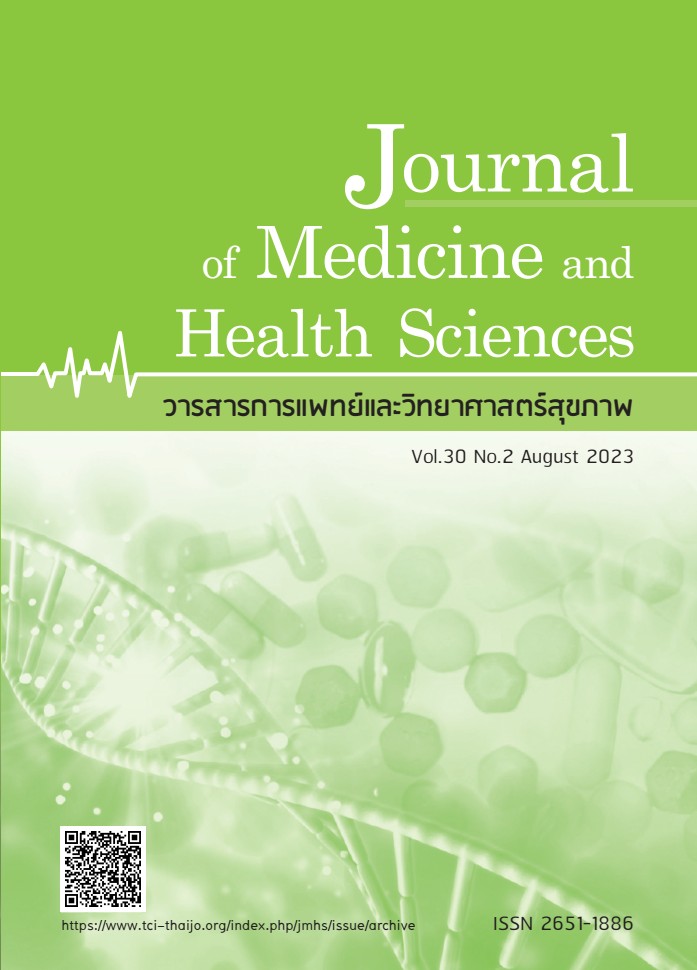Effects of milk consumption on lipid profile changes among individuals with metabolic syndrome
Keywords:
cow milk, soy milk with milk powder, high calcium soy milk no sugar added, lipid profileAbstract
Metabolic syndrome is a risk factor of cardiovascular disease. Some studies have shown the benefit of consuming soy products could decrease lipid profile. This clinical study aimed to study the effect of consuming various types of milk on lipid profile changes among individuals with metabolic syndrome. There were 70 participants with metabolic syndrome were randomized into four groups: Group 1 received cow milk, Group 2 soy milk with milk powder, Group 3 high calcium soy milk, plain and with no sugar added, and Group 4 high calcium soy milk, multigrain and with no sugar added. Groups 1 and 2 consumed 500 ml of milk daily, while Groups 3 and 4 consumed 460 ml of milk daily. Milk was consumed twice daily 15-30 minutes before breakfast and dinner for eight weeks. The serum lipid profile was determined in weeks 0, 4 and 8. The methodology used One-Way repeated measures ANOVA and the Friedman two-way analysis of variance to analyze the differences within each group. A One-Way ANOVA and a Kruskal-Wallis test was used to analyze the differences between groups, and the statistical significance was defined with a p-value<0.05. The results of within-group comparisons revealed that all four types of milk significantly raised HDL-cholesterol from Week 4. For soy milk with milk powder and high calcium soy milk, plain, no sugar added, significantly reduced LDL- cholesterol in Week 8. There were no significant changes observed in the level of total cholesterol and triglycerides across all groups. The between-group comparisons showed that LDL-cholesterol of high calcium soy milk, plain, with no sugar added group was significantly lower those for that in the cow milk and high calcium soy milk, multigrain, no sugar added group. Moreover, high calcium soy milk, plain and no sugar added exhibited significantly lower total cholesterol than other groups. Therefore, consuming cow milk and three types of soy milk could improve serum lipid profile.
References
International Diabetes Federation. The IDF worldwide definition of the metabolic syndrome Belgium: IDF Communications; 2006.
Aekplakorn W, Pakjaroen H, Thaikla K, et al. Thai National Health Examination Survey V. Nonthaburi: Health Systems Research Institute; 2016.
Rivas M, Garay RP, Escanero JF, et al. Soy milk lowers blood pressure in men and women with mild to moderate essential hypertension. J Nutr 2002;132(7):1900-2.
Tokede OA, Onabanjo TA, Yansane A, et al. Soya products and serum lipids: a meta-analysis of randomised controlled trials. Br J Nutr 2015;114(6):831-43.
Engel S, Elhauge M, Tholstrup T. Effect of whole milk compared with skimmed milk on fasting blood lipids in healthy adults: a 3-week randomized crossover study. Eur J Clin Nutr 2018;72(2):249-54.
Önning G, Åkesson B, Öste R, et al. Effects of consumption of oat milk, soya milk, or cow’s milk on plasma lipids and antioxidative capacity in healthy subjects. Ann Nutr Metab 1998;42(4):211-20.
Indrani D, Swetha P, Soumya C, et al. Effect of multigrains on rheological, microstructural and quality characteristics of north Indian parotta–An Indian flat bread. LWT-Food Sci Technol 2011;44(3):719-24.
Grundy SM, Hansen B, Smith Jr SC, et al. Clinical management of metabolic syndrome: report of the American Heart Association/National Heart, Lung, and Blood Institute/American Diabetes Association conference on scientific issues related to management. Circulation 2004;109(4):551-6.
Sakpal TV. Sample size estimation in clinical trial. Perspect Clin Res 2010;1(2):67-69.
Weidner C, Krempf M, Bard J-M, et al. Cholesterol lowering effect of a soy drink enriched with plant sterols in a French population with moderate hypercholesterolemia. Lipids Health Dis 2008;7(1):1-8.
Gardner CD, Messina M, Kiazand A, et al. Effect of two types of soy milk and dairy milk on plasma lipids in hypercholesterolemic adults: a randomized trial. J Am Coll Nutr 2007;26(6):669-77.
Bricarello LP, Kasinski N, Bertolami MC, et al. Comparison between the effects of soy milk and non-fat cow milk on lipid profile and lipid peroxidation in patients with primary hypercholesterolemia. Nutrition 2004;20(2):200-4.
Mensink RP, Zock PL, Kester AD, et al. Effects of dietary fatty acids and carbohydrates on the ratio of serum total to HDL cholesterol and on serum lipids and apolipoproteins: a meta-analysis of 60 controlled trials. Am J Clin Nutr 2003;77(5):1146-55.
Braaten J, Scott F, Wood P, et al. High β‐glucan oat bran and oat gum reduce postprandial blood glucose and insulin in subjects with and without type 2 diabetes. Diabet Med 1994;11(3):312-8.
Pick ME, Hawrysh ZJ, Gee MI, et al. Oat bran concentrate bread products improve long-term control of diabetes: a pilot study. J Am Diet Assoc 1996;96(12):1254-61.
Ravichanthiran K, Ma ZF, Zhang H, et al. Phytochemical profile of brown rice and its nutrigenomic implications. Antioxidants 2018;7(6):71.
Downloads
Published
How to Cite
Issue
Section
License

This work is licensed under a Creative Commons Attribution-NonCommercial-NoDerivatives 4.0 International License.



